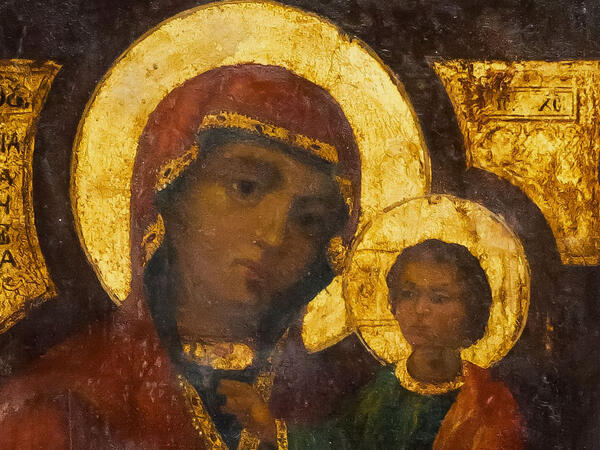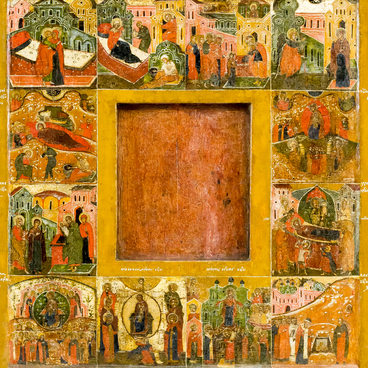The icon depicting Panagia Portaitissa was created in the 19th century. In the Eastern Orthodox culture, there is a tradition of making copies of the most venerated icons. The originals can be very ancient, or sometimes lost — fortunately, the miracle working copy images will most likely remain preserved. Some of the copies are more than one hundred years old and are as valuable as the original icons.
This icon is a copy of the ancient miracle working icon ‘The Iverskaya Mother of God (Panagia Portaitissa)’. The original is still kept at the Iviron Monastery on Mount Athos. The relic was called Panagia Portaitissa because of a legend which says that the icon appeared over the main gates of the Iviron Monastery by itself several times.
This 19th century copy was created by the Greek artist Nikolaos K. Sklavopoulos. The name of the painter was identified by a specialist from the Kazan Theological Seminary Natalya Asyaeva during the preparations for a large exhibition ‘The Miracle Working Kazan Image of the Mother of God. The Kazan Virgin Monastery’ in 2016.
Nikolaos K. Sklavopoulos painted ‘Panagia Portaitissa’ on a cypress panel. He made significant changes to the composition: the painter placed the holy image not in a rectangular frame, as was the case with the miracle working Athos icon, but in an almost square-shaped reliquary. Moreover, Sklavopoulos depicted the faces of the Virgin and the Child in a way different from the original.
As for the color scheme, it is difficult to find the difference between the two icons, for the 19th century image of the Virgin from the museum collection has never been restored. It is covered with a darkened layer of flaxseed oil varnish — a specially prepared oil used as a protective layer in icon painting. Over time, the oil always darkens as it dries, thus changing the color of the icon.
On the carved borders of the icon, there are images of double-headed eagles and equal-armed crosses. Each upper medallion depicts a double-headed eagle wearing a crown, holding the orb and cross — a symbol of power. This type of eagle is also found on the coat of arms of the Patriarch of Constantinople. Patriarch Joachim III plays an important role in the story of how this Panagia Portaitissa icon of the Mother of God appeared in Kazan.
In 1904, he was one of the first people to express support to the residents of Kazan after the miracle working icon Our Lady of Kazan was stolen. In April 1906, Patriarch Joachim III presented the Kazan Virgin Monastery with a copy of ‘All Blessed’ Icon of the Mother of God, and two years later — the Panagia Portaitissa icon of the Mother of God. On the back of the latter, there is an inscription confirming the donation of the image to the abbess of the monastery — Abbess Margarita.
In the 1930s, after the monastery was closed, the relic was transferred to the State Museum of the Tatar ASSR.
This icon is a copy of the ancient miracle working icon ‘The Iverskaya Mother of God (Panagia Portaitissa)’. The original is still kept at the Iviron Monastery on Mount Athos. The relic was called Panagia Portaitissa because of a legend which says that the icon appeared over the main gates of the Iviron Monastery by itself several times.
This 19th century copy was created by the Greek artist Nikolaos K. Sklavopoulos. The name of the painter was identified by a specialist from the Kazan Theological Seminary Natalya Asyaeva during the preparations for a large exhibition ‘The Miracle Working Kazan Image of the Mother of God. The Kazan Virgin Monastery’ in 2016.
Nikolaos K. Sklavopoulos painted ‘Panagia Portaitissa’ on a cypress panel. He made significant changes to the composition: the painter placed the holy image not in a rectangular frame, as was the case with the miracle working Athos icon, but in an almost square-shaped reliquary. Moreover, Sklavopoulos depicted the faces of the Virgin and the Child in a way different from the original.
As for the color scheme, it is difficult to find the difference between the two icons, for the 19th century image of the Virgin from the museum collection has never been restored. It is covered with a darkened layer of flaxseed oil varnish — a specially prepared oil used as a protective layer in icon painting. Over time, the oil always darkens as it dries, thus changing the color of the icon.
On the carved borders of the icon, there are images of double-headed eagles and equal-armed crosses. Each upper medallion depicts a double-headed eagle wearing a crown, holding the orb and cross — a symbol of power. This type of eagle is also found on the coat of arms of the Patriarch of Constantinople. Patriarch Joachim III plays an important role in the story of how this Panagia Portaitissa icon of the Mother of God appeared in Kazan.
In 1904, he was one of the first people to express support to the residents of Kazan after the miracle working icon Our Lady of Kazan was stolen. In April 1906, Patriarch Joachim III presented the Kazan Virgin Monastery with a copy of ‘All Blessed’ Icon of the Mother of God, and two years later — the Panagia Portaitissa icon of the Mother of God. On the back of the latter, there is an inscription confirming the donation of the image to the abbess of the monastery — Abbess Margarita.
In the 1930s, after the monastery was closed, the relic was transferred to the State Museum of the Tatar ASSR.



